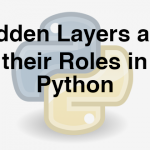
Link to the previous post : https://statinfer.com/204-5-11-hidden-layers-and-their-roles/
As promised, in the first post of the series we will build a Neural Network that will read the image of a digit and correctly identify the number.
Practice : Digit Recognizer
- Take an image of a handwritten single digit, and determine what that digit is.
- Normalized handwritten digits, automatically scanned from envelopes by the U.S. Postal Service. The original scanned digits are binary and of different sizes and orientations; the images here have been de slanted and size normalized, resultingin 16 x 16 grayscale images (Le Cun et al., 1990).
- The data are in two gzipped files, and each line consists of the digitid (0-9) followed by the 256 grayscale values.
- Build a neural network model that can be used as the digit recognizer.
- Use the test dataset to validate the true classification power of the model
- What is the final accuracy of the model?
- We can see them as multiple lines on the decision space

In [55]:
#Importing test and training data
import numpy as np
digits_train = np.loadtxt("datasets\\Digit Recognizer\\USPS\\zip.train.txt")
In [56]:
#digits_train is numpy array. we convert it into dataframe for better handling
train_data=pd.DataFrame(digits_train)
train_data.shape
Out[56]:
In [57]:
digits_test = np.loadtxt("datasets\\Digit Recognizer\\USPS\\zip.test.txt")
#digits_test is numpy array. we convert it into dataframe for better handling
test_data=pd.DataFrame(digits_test)
test_data.shape
Out[57]:
In [58]:
train_data[0].value_counts() #To get labels of the images
Out[58]:
In [59]:
import matplotlib.pyplot as plt
#Lets have a look at some images.
for i in range(0,5):
data_row=digits_train[i][1:]
#pixels = matrix(as.numeric(data_row),16,16,byrow=TRUE)
pixels = np.matrix(data_row)
pixels=pixels.reshape(16,16)
plt.figure(figsize=(10,10))
plt.subplot(3,3,i+1)
plt.imshow(pixels)
In [60]:
#Creating multiple columns for multiple outputs
#####We need these variables while building the model
digit_labels=pd.DataFrame()
digit_labels['label']=train_data[0:][0]
label_names=['I0','I1','I2','I3','I4','I5','I6','I7','I8','I9']
for i in range(0,10):
digit_labels[label_names[i]]=digit_labels.label==i
#see our newly created labels data
digit_labels.head(10)
Out[60]:
In [61]:
#Update the training dataset
train_data1=pd.concat([train_data,digit_labels],axis=1)
print(train_data1.shape)
train_data1.head(5)
Out[61]:
In [62]:
#########Neural network building
import neurolab as nl
import numpy as np
import pylab as pl
x_train=train_data.drop(train_data.columns[[0]], axis=1)
y_train=digit_labels.drop(digit_labels.columns[[0]], axis=1)
In [63]:
#getting minimum and maximum of each column of x_train into a list
def minMax(x):
return pd.Series(index=['min','max'],data=[x.min(),x.max()])
In [64]:
listvalues = x_train.apply(minMax).T.values.tolist()
error = []
In [66]:
# Create network with 1 layer and random initialized
net = nl.net.newff(listvalues,[20,10],transf=[nl.trans.LogSig()] * 2)
net.trainf = nl.train.train_rprop
In [67]:
# Train network
import time
start_time = time.time()
error.append(net.train(x_train, y_train, show=0, epochs = 250,goal=0.02))
print("--- %s seconds ---" % (time.time() - start_time))
In [68]:
# Prediction testing data
x_test=test_data.drop(test_data.columns[[0]], axis=1)
y_test=test_data[0:][0]
predicted_values = net.sim(x_test.as_matrix())
predict=pd.DataFrame(predicted_values)
index=predict.idxmax(axis=1)
In [69]:
#confusion matrix
from sklearn.metrics import confusion_matrix as cm
ConfusionMatrix = cm(y_test,index)
print('Confusion Matrix : ', ConfusionMatrix)
#accuracy
accuracy=np.trace(ConfusionMatrix)/sum(sum(ConfusionMatrix))
print('Accuracy : ', accuracy)
error=1-accuracy
print('Error : ', error)



